Halifax Town Hall
Seat of Local Governance
Halifax Town Hall is a magnificent building which stands proudly close to the centre of the Town. It is grade II* listed and was built in the 19th century. It is notable for its design and interiors by Charles Barry and his son, Edward Middleton Barry, and for its sculptures by John Thomas. The town hall is also the headquarters of Calderdale Metropolitan Borough Council.
The Mayor and corporation first proposed that they build a new town hall in 1847. They suggested it again in 1853 after the town had become a borough five years earlier but they still had no central offices. They proposed it again in 1856. The later proposals were prompted by the 1853 Improvement Act, which allowed the borough to borrow £15,000 to build a town hall, courthouse and police station. The 1856 proposal was also prompted by John Crossley, who was at that time developing Princess Street and Crossley Street, using the architects Lockwood and Mawson who later designed Bradford City Hall. This may explain why the town hall blends in with several Crossley Street buildings, which are now listed as a group.
The council, Edward Akroyd and John Crossley requested that Charles Barry judge the design entries; he disliked all three entries and was asked in turn to submit his own design. His design was accepted, but he died in 1860. His son, Edward Middleton Barry, completed the design which was erected on a 148 x 90 ft plot on John Crossley's land. The foundation stone was laid in 1861. Whiteley Brothers were the builders. It was listed on 31 July 1963.
For the opening of the town hall 358 trains brought 70,000 people, and thousands more walked to attend a two-day session of openings and visits in Halifax by the Prince of Wales, later King Edward VII, on 3 and 4 August 1863. There was a grand procession to the town hall on 4 August, through decorated streets. This was followed by a service in the Piece Hall at which thousands of children sang hymns while 870 police controlled the crowd. Perhaps Victoria herself might have opened the town hall, but for her widowhood in 1861 and her subsequent retirement from public life. Edward was 22 years old, and had married the 18-year-old Princess Alexandra in March of that year, however by 4 August she was four months pregnant with the future Duke of Clarence, pleaded illness and did not attend the opening, to much public disappointment. It rained:
"Even though shorn of its principal attraction through the unfortunate absence of the Princess of Wales, and though dimmed as regards its pomp and circumstance owing to the rain which fell at so very inconvenient a time, the opening of the new town hall by the Prince of Wales is still an event of which Halifax may well be proud ... The enthusiasm and almost unbounded devotion of a people to their future monarch has been symbolised in every form of decorative skill and beauty, by gay banners, many coloured flags and the ornamentations of the designers, vying with nature, ever profuse in her lovely gifts, to form floral designs of the most varied, chaste and unique description. Our very streets were redolent with the fragrance of the flower garden ... The rain began to fall somewhat heavily by eleven o'clock on Monday night and, as far as we can learn, continued to fall all night. From a very early hour in the morning it descended literally in torrents, ceaselessly, pitilessly. It would be impossible to calculate the amount of real misery experienced here." Halifax Courier, August 1863
When Edward arrived by royal train on 3 August, he was greeted with a salute by two guns on Beacon Hill, and a guard of honour comprising 300 soldiers. There was a banquet at Manor Heath, where 100 people serenaded him in the rain, then there was a balloon ascent and a firework display. Hundreds of men had to be drafted in to control crowds arriving at Halifax railway station, and more were placed along the line to control the hundreds of extra trains. When the town hall was opened to the public on 11 August, the mayor presented four marble busts of Victoria, Albert, Edward and Alexandra. These were put in storage from 1954 after redecoration and restored to public view on 6 September 2008.
We are very grateful to Wikipedia for a very comprehensive entry please visit their site for the full details https://en.wikipedia.org/wiki/Halifax_Town_Hall you may also wish to visit the calderdale wensite for more information https://www.calderdale.gov.uk/wtw/search/controlservlet?PageId=Detail&DocId=102710
Related pages...
Calderdale Royal Hospital
more The main Hospital for the the town
Shaw Lodge Mills
more A brief history of this icon of the textile industry in the Halifax area

The Shay Stadium
more The home of professional sport in the town

Eureka! The National Children's Museum
more A popular children's museum
The Halifax Building Society
more Headquarters of the eponymous financial institute
_1.jpg)
Wainhouse Tower
more A victorian "Folly"
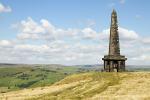
Stoodley Pike
more A war memorial in the Todmorden area
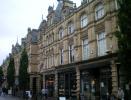
The Halifax Borough market
more The victorian covered market in the town centre
_1.jpg)
Square Church Spire
more The spire is all that remains of this church
_1.jpg)
The Piece Hall
more Halifax's jewel in the crown
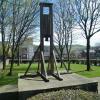
The Halifax Gibbet
more A forerunner of the Guillotine

Halifax Minster
more The centre of worship in Town

Dean Clough
more An industrial powerhouse of the past
_1.jpg)
All Souls Church
more The church of a former model village
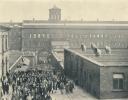
Black Dyke Mills
more An icon on the outskirts of Halifax
back to page above this...
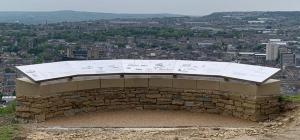
The Centenary Viewing Platform at Beacon Hill
back To celebrate 100 years of service to the town of Halifax we have commissioned viewing platform on Beacon Hill overlooking the town. Situated on the Magna Via, an old packhorse route, the walk to the top is worth it.